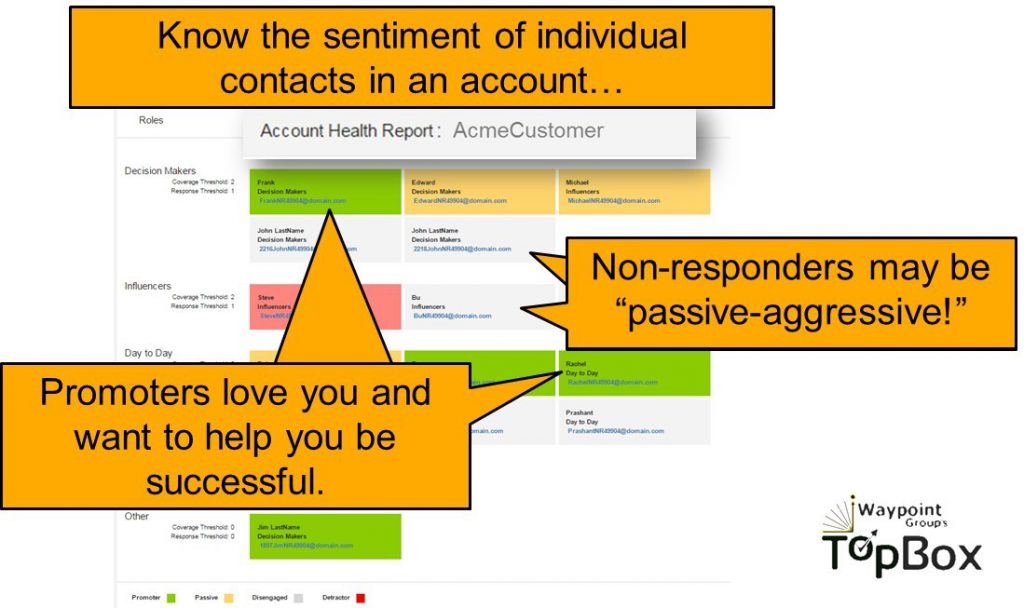Search Waypoint Resources
How The Marketing Playbook Can Help You Score A Success Touchdown

American football is all about advancing down the field, incrementally moving toward the objective: a touchdown. The players are executing the strategy and plays from the coach’s playbook, to gain all important yardage. The plays are well defined, they’re repeatable and strategic and they strive for a common goal, to get the ball over the line.
Similarly, the Marketing department, as the communications and growth engine for the company, holds the playbook; Marketers are the strategists who need to be responsible for revenue. They excel at programmable and ongoing strategy. Who better to run the plays which are going to ensure you keep and expand your existing customers and find new ones?
While most Marketing organizations focus on acquiring new ‘logos,’ there is a great deal to expand upon in the existing accounts you already have — they’re the bird you already have in hand. Expanding your existing accounts doesn’t have to be a difficult process, run the right plays so that when you go into the game, you’re ready.
There’s a feeling in most companies that the sales team and account management / CS (Customer Success) teams are supposed to be focused on farming the existing accounts for new opportunities. Yes, they are. And just like Marketing sending over leads new customer acquisition, Marketing must also be sending over new opportunities from the existing customer base.
The ways in which you can do this are straightforward and can be built into the work already being done.
Just like with building buyer personas, the task of Marketing is to find out who the real contacts in every account are, the Decision Makers and key Influencers, and find out where there are opportunities. Correspondingly in existing accounts, by finding out the sentiment of the account, their happiness or displeasure, and using this information to help the front-line accounts team execute the right play, there’s a wealth of opportunity to be had.
The first thing that you need to do to expand your existing accounts is identify the promoters/ advocates that you have within it and call upon them in a personal way to introduce you to the other parts of the business. They’re your fans, the supporters who come to your games and cheer for you, the people who will talk about you to their friends and colleagues. Identifying those promoters allows you to cater specifically to them and help to harness their power.

Secondly, the identification of detractors is pivotal. Finding those unhappy people who are negatively affecting your business and spreading bad word of mouth is crucial to counteract and ideally to “convert” them. Every coach knows the detractors, they’re your opposition linemen, whose job seems to be to block your players at every turn and stop you moving up field. Every good coach needs to know the stats and the playing style of opposing linemen, so they can effectively neutralize them and run the ball. As Marketers, get to know your Detractors so you can learn what shapes these attitudes and hand them over to your sales and CS teams, who are your receivers and running-backs, and make sure you can get the crucial touchdown — a renewal, added professional services, whatever the situation needs.
Connecting with these unhappy customers provides an opportunity to identify and solve the problems which caused the disconnect in the first place — they’re at least invested enough to tell you what’s wrong! It’s like the opposing team letting you peak at their playbook — use that advantage if you’ve got it. Even in the worst of detractor situations, where the account cannot be saved, this strategy will improve marketing messaging and avoid a repeated cycle with similar customer accounts.
Some might think that the identification of promoters and detractors is purely the domain of sales/CS, but the work they’re doing on the front-line is just like receivers and running backs. Their job is to receive the passes and bring the ball over the line dealing with the fracas which is in their immediate way, as they’re involved in the day-to-day tactics of maintaining accounts, not a program.
Marketers typically flourish in a programmatic environment and work well planning the campaigns and plays which can be launched, just like a coach. They’re the ones with the playbook in hand, analyzing and working out how best to get Sales and CS over the line. While your CS team works on the day to day, your marketers work toward the future to evaluate and predict. Marketing must assess the field and the players on hand, and work with the rest of the team to score a touchdown.
Identifying the clients who are championing you is the key. Only then can you activate and create more advocates and put more points on the board in the most efficient and effective way possible.
Start with your Strategic Accounts — Are they the most successful?